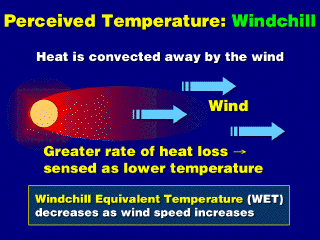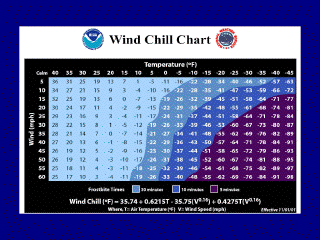 As you stand around in the air, you sense the temperature
as "cool" or "warm", based on how quickly you lose body
heat to the environment (the rate of conduction
is proportional to the difference in temperature between two objects). Air is
a poor conductor, and without any convection
(wind), the thin layer of air surrounding you quickly reaches a temperature
that is very close to your body temperature, keeping the heat loss to a low
but non-zero level.
As you stand around in the air, you sense the temperature
as "cool" or "warm", based on how quickly you lose body
heat to the environment (the rate of conduction
is proportional to the difference in temperature between two objects). Air is
a poor conductor, and without any convection
(wind), the thin layer of air surrounding you quickly reaches a temperature
that is very close to your body temperature, keeping the heat loss to a low
but non-zero level.
 Adding wind changes the heat transport situation. A wind convects away the
warmed air surrounding the body and replaces it with the cooler, ambient air.
This means you have to lose some more body heat to warm the air back up. But
this air is also blown away by the wind. Essentially, the body heat loss rate
is increased by the convection. You will now sense a new, lower temperature
based on this increased heat loss rate. We can determine a windchill equivalent
temperature (WET) that would be the temperature of calm air that results
in the same amount of body heat loss.
Adding wind changes the heat transport situation. A wind convects away the
warmed air surrounding the body and replaces it with the cooler, ambient air.
This means you have to lose some more body heat to warm the air back up. But
this air is also blown away by the wind. Essentially, the body heat loss rate
is increased by the convection. You will now sense a new, lower temperature
based on this increased heat loss rate. We can determine a windchill equivalent
temperature (WET) that would be the temperature of calm air that results
in the same amount of body heat loss.
 As the wind speed increases, the windchill equivalent temperature decreases
for a fixed actual air temperature. While the WET might be chilly to people
at many combinations of environmental conditions, the situation becomes harmful
to people if the WET drops well below freezing. This is because your health
depends on how much body heat you're losing to the environment, which is exactly
(and inversely) proportional to the WET, not the actual air temperature.
As the wind speed increases, the windchill equivalent temperature decreases
for a fixed actual air temperature. While the WET might be chilly to people
at many combinations of environmental conditions, the situation becomes harmful
to people if the WET drops well below freezing. This is because your health
depends on how much body heat you're losing to the environment, which is exactly
(and inversely) proportional to the WET, not the actual air temperature.
This is very significant for windy
conditions when the actual air temperature is below 0 degrees Celsius; for higher
air temperatures, the WET will usually only be low enough to be uncomfortable
but not especially unhealthful.


 As you stand around in the air, you sense the temperature
as "cool" or "warm", based on how quickly you lose body
heat to the environment (the rate of conduction
is proportional to the difference in temperature between two objects). Air is
a poor conductor, and without any convection
(wind), the thin layer of air surrounding you quickly reaches a temperature
that is very close to your body temperature, keeping the heat loss to a low
but non-zero level.
As you stand around in the air, you sense the temperature
as "cool" or "warm", based on how quickly you lose body
heat to the environment (the rate of conduction
is proportional to the difference in temperature between two objects). Air is
a poor conductor, and without any convection
(wind), the thin layer of air surrounding you quickly reaches a temperature
that is very close to your body temperature, keeping the heat loss to a low
but non-zero level. Adding wind changes the heat transport situation. A wind convects away the
warmed air surrounding the body and replaces it with the cooler, ambient air.
This means you have to lose some more body heat to warm the air back up. But
this air is also blown away by the wind. Essentially, the body heat loss rate
is increased by the convection. You will now sense a new, lower temperature
based on this increased heat loss rate. We can determine a windchill equivalent
temperature (WET) that would be the temperature of calm air that results
in the same amount of body heat loss.
Adding wind changes the heat transport situation. A wind convects away the
warmed air surrounding the body and replaces it with the cooler, ambient air.
This means you have to lose some more body heat to warm the air back up. But
this air is also blown away by the wind. Essentially, the body heat loss rate
is increased by the convection. You will now sense a new, lower temperature
based on this increased heat loss rate. We can determine a windchill equivalent
temperature (WET) that would be the temperature of calm air that results
in the same amount of body heat loss. As the wind speed increases, the windchill equivalent temperature decreases
for a fixed actual air temperature. While the WET might be chilly to people
at many combinations of environmental conditions, the situation becomes harmful
to people if the WET drops well below freezing. This is because your health
depends on how much body heat you're losing to the environment, which is exactly
(and inversely) proportional to the WET, not the actual air temperature.
As the wind speed increases, the windchill equivalent temperature decreases
for a fixed actual air temperature. While the WET might be chilly to people
at many combinations of environmental conditions, the situation becomes harmful
to people if the WET drops well below freezing. This is because your health
depends on how much body heat you're losing to the environment, which is exactly
(and inversely) proportional to the WET, not the actual air temperature.